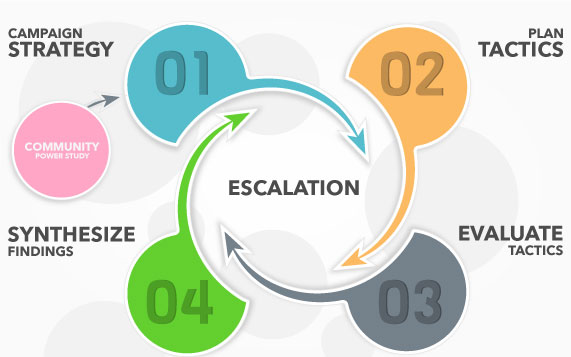Benjamin Local Classified Employees Win Union Election
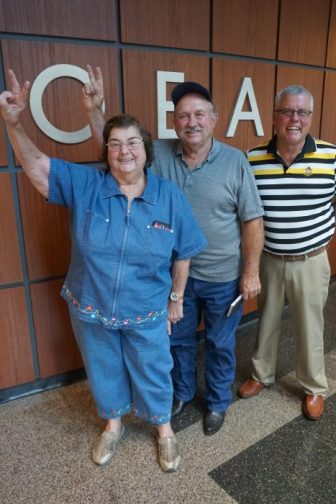
Joyce Fish loves her students. For 41 years, she has driven the students of the Benjamin Logan Local School District in her familiar yellow bus.
Located in eastern Logan county, near Bellefontaine, Ohio, the terrain can be challenging. “You learn to respect the weather, rugged hills, and steep valleys,” says Dan Fish; yes, Joyce’s husband and colleague.
However, after years of feeling they were not getting any love or respect from district administrators, in December 2017 they reached the Ohio Education Association.
Their efforts paid off — they’re no longer at-will employees and have a seat at the table. Results, tallied July 24, by the State Employment Labor Relations Board, show workers voted an overwhelming 73% in favor of OEA representation.
For the first time in more than 30 years, the district’s 70+ bus drivers, cafeteria workers, educational assistants, and paraprofessional aides will have will have union representation.
They will join the district’s 115+ educators of the Benjamin Logan EA, who have been a part of OEA since 1974.
Joyce and Dan say they’re looking forward to the collective-bargaining process. “Unanswered demands for respect as well as ‘fair and equal treatment for everyone,’ tell a story of professionals who are tired of being pushed around,” says Joyce.
![]()
 Oh Yes, We’re Social — Join the Conversation!
Oh Yes, We’re Social — Join the Conversation!
![]()
Stand Strong for Public Education…Together, We Can!
 Janus v. AFSCME?
Janus v. AFSCME?
Through our union, we advocate for what our students deserve and for what educators need to do our jobs well. However, the U.S. Supreme Court will likely issue a decision in the case this week that could threaten our collective voice. Janus v. AFSCME is a politically motivated attack to use the U.S. Supreme Court to divide and conquer our union by eliminating the fair share fee.
Why Does It Matter
Janus v. AFSCME is part of a concerted effort to weaken our ability to advocate for our students and members. Negotiating collectively improves the lives of all working people—even those who are not union members themselves—because strong unions set pay and benefit standards that non-union employers follow. This means stronger communities. At its core, the Janus case is about working people’s freedom to make a better life for themselves, their families, and their communities.
What Are We Doing About It?
Together, we are continuing the fight for strong public schools by strengthening our locals and demonstrating value and relevance to our members. | #OEAstrong
Download the Strong OEA = Strong Public Schools fact card for additional details about Janus v. AFSCME.
![]()
 Oh Yes, We’re Social — Join the Conversation!
Oh Yes, We’re Social — Join the Conversation!
![]()
Updated June 4, 2018
OEA Locals Establishing Measurable Goals
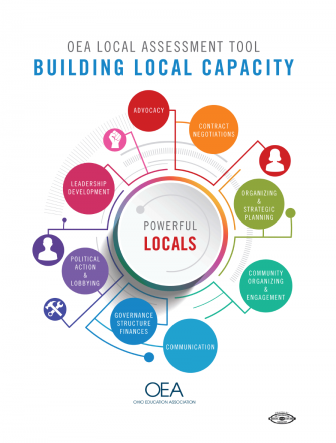 The OEA Organizing Department has developed a Local Self-Assessment Tool that can aide your local in targeting crucial areas of growth. Many locals have already begun to use this tool in order to assist them in strategic planning and goal setting. An active and strong local is always assessing their members’ needs and looking for ways in which to grow collective power. The OEA Local Assessment Tool looks at several key indicators that a well-rounded local should take into consideration for increased growth and strength. These are the following: Advocacy, contract negotiations, organizing and strategic planning, community organizing and engagement, communication, political action and lobbying, leadership development and governance structure/finances.
The OEA Organizing Department has developed a Local Self-Assessment Tool that can aide your local in targeting crucial areas of growth. Many locals have already begun to use this tool in order to assist them in strategic planning and goal setting. An active and strong local is always assessing their members’ needs and looking for ways in which to grow collective power. The OEA Local Assessment Tool looks at several key indicators that a well-rounded local should take into consideration for increased growth and strength. These are the following: Advocacy, contract negotiations, organizing and strategic planning, community organizing and engagement, communication, political action and lobbying, leadership development and governance structure/finances.
The tool is very useful for locals and provides them with an accurate reading on their overall organizational effectiveness and readiness. The process walks the self-assessment team through a number of steps to target areas of growth. Once this is achieved, the findings are discussed, and a consensus is reached, the real work begins.
Once the areas of growth are identified the local should develop a plan that sets up short term and long term (measurable or S.M.A.R.T.) goals. What should be achieved right now? What should we attempt to tackle in the long term? Resources and finances? Responsibility and accountability for the established outcomes? These are all questions to think about as locals plan for the future. You need to know where you are going before you figure out how to get there. One step at a time and strategic planning is the key.
This is also a great opportunity to engage and involve your members to participate and take ownership of the locals’ direction and vision. It provides them with a stronger voice and by doing so, they build a stronger local and union alongside their leaders.
I suggest that smaller locals take “smaller” steps so that the tool does not become cumbersome or overwhelming for them. The Organizing Dept. is now developing a shorter “field version” of the original tool. The Local Assessment Tool can be requested by sending us an e-mail or a hard copy can be obtained from your LRC.
Thank you for all you do and remember to keep ORGANIZING!
Ryan Dunn
OEA Director of Organizing & Member Engagement
dunnr@ohea.org
Successful member organizing helps Maysville EA become first Ohio local to win back salary schedule
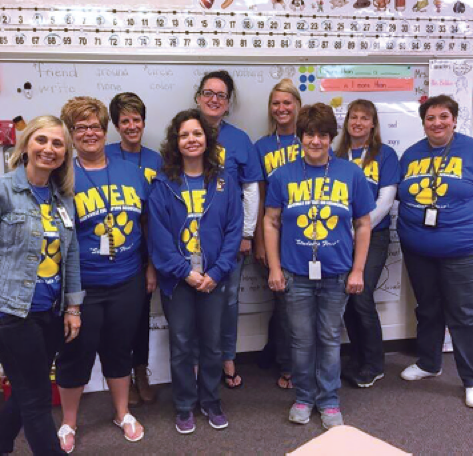 In 2014, midway through the freeze, the administration presented MEA with a “white knight” solution known as alternative compensation developed with the guidance of Battelle for Kids, a non-profit organization intent on tying teacher employment and pay for performance based upon student test scores.
In 2014, midway through the freeze, the administration presented MEA with a “white knight” solution known as alternative compensation developed with the guidance of Battelle for Kids, a non-profit organization intent on tying teacher employment and pay for performance based upon student test scores.
Still reeling from stagnant wages and the defeat of SB5, members made the short-term decision to accept the alternative compensation proposal that came packaged with sweeteners and incentives, many of which were grant-based. Despite warnings from the local’s OEA labor relations consultant that the inequities of the system would be revealed once grant money disappeared, and that a return to their salary schedule might be impossible, 95% of voting members accepted the new compensation plan and, ultimately, its failures.
This year the exit of prior school district management and hiring of a superintendent who was not a strong advocate of tying teacher pay or evaluations to student test results, encouraged a group of MEA members to pursue a return to a traditional pay scale—used by 97% of Ohio school districts.
According to MEA President Myra Warne this was no small challenge for a local with 140 members in rural southeastern Ohio. “Nobody could remember the last time more than 25 or 30 people had come to a meeting,” Warne said. “And, as is often the case with small locals, previous negotiations had been informal and often occurred without the benefit of labor experts at the table.”
As newly elected MEA president, Warne, an English teacher at Maysville High School, promised member involvement and transparency in the process, recognizing that neither would be possible unless teachers were willing to unite behind the goal of achieving an equitable contract that would serve the best interests of all members.
“Nearly a quarter of our members were doing better with merit pay than they would have with the traditional system,” Warne said. “Some wouldn’t receive a raise if MEA returned to the old salary schedule because they had passed the top rung, but the other 75 percent of members had seen their pay stagnate for years. We had to convince those who were benefiting from the new system to support our efforts with the understanding that when management pits us against one another, it’s bad for the union as a whole.”
The MEA Executive Committee recognized that achieving its goal would require a plan to foster member engagement, beginning with a negotiations committee. An all-call for negotiating committee members produced 10 volunteers from different work areas and buildings who agreed to meet weekly, beginning in January 2017.
At the initial meeting, the team developed a plan with each committee member assigned an article of the existing collective bargaining agreement for review and recommendations. With the help of the local’s new LRC Jeremy Baiman, the group dissected the agreement, focusing on key areas. The team sought input from non-committee members in specific disciplines such as special education.
The group then took the unprecedented action of opening every article of the contract, something that had not been done in decades. They discovered a clause suggesting that the superintendent had the right to determine whether a teacher who had given birth was emotionally fit to return to work. In other areas, such as family medical leave, contract language was in violation of federal law.
Committee members were assigned review of specific articles. They also examined contracts from other locals and survey responses from MEA members, and made recommendations based on their research. After discussion, the group agreed on bargaining priorities.
Another critical step was analyzing the district’s spending and financials. On behalf of the MEA, the OEA filed a Freedom of Information Act request for all district salaries and compensation that revealed wide disparities in pay.
Warne said the committee found one teacher who would need to work 21 years under the alternative compensation plan to reach a salary of $51,500—the amount earned by the district’s executive secretaries. The member agreed to serve as a poster child for MEA’s efforts.
“It wasn’t enough to just say, ‘This is good for young teachers,’” Warne said. “We made sure we had permission to use member names, both at the bargaining table and with other members, so that we would have concrete examples.”
MEA’s research also revealed that the district was
top-heavy in administrative salaries—employing 17 administrators at a cost of $1.5 million to taxpayers, compared to 12 administrators in a similar-sized neighboring district. The union’s analysis of the district’s financials showed that the year it implemented merit pay, Maysville saved $700,000 in staff payroll. While the district was pleading poverty, its books showed $1.3 million in revenue over expenses.
Warne said, “exposing and highlighting these financial disparities engaged members, but we needed a strategy to sustain engagement and support throughout the bargaining process to ensure our success.”
Regular communication was key to providing the transparency promised to members early in the process. Committee members secured personal email address and cell phone numbers for each member and contacted teachers to collect accurate information regarding years of service and education levels.
Determining the cost for MEA’s proposal was crucial to securing a deal and math teacher Amber Williams spent hours creating formulae and manipulating data with respect to various counter proposals on compensation.
Communications team members Toni Stoepfel and Samantha Mitts kept members informed in real time, sending emails and text messages updating teachers on the progress of negotiations, and encouraging them to show solidarity by wearing member shirts, participating in group walk-ins, and wearing daily assigned colors to demonstrate unity.
Committee members were motivated and encouraged when, on the first day of negotiations, teachers showed up at school in MEA shirts and posted group pictures
to Facebook.
“As negotiations continued, we received motivational texts and emails from appreciative members, demonstrating the real reward—the fact that we were working hard on behalf of all members,” Warne said.
MEA kept members informed of the substance of negotiations and made sure they were involved in key decisions.
“After the first two days of bargaining, in which the district insisted on maintaining the merit pay system,
we told their negotiating team we needed member input before we could proceed,” Warne said. “On May 9, we held a meeting attended by two-thirds of our members—absolutely unheard of in our district—and presented members with three choices: continue to fight for the traditional step system; acquiesce to the alternative compensation scheme, but try to get a better deal; or work with the administration to come up with a combination of the two.”
Attendees voted soundly (91%) to continue MEA’s fight to regain the traditional pay scale, and the committee secured petition signatures from 87% of all members, signaling that they would do whatever it took to achieve the desired result.
A turning point for MEA was the attendance of 90 members at a school board meeting—so many members that the school board hired a deputy sheriff to attend the proceedings.
Bargaining concluded June 2 with a return to the traditional pay scale—making MEA the first local in Ohio to win back its salary schedule after giving it up.
Additional contract gains included a grandfather clause, ensuring that members who had exceeded their step-based salary would not take a pay cut, financial penalties for the district for exceeding class size targets, and additional release days for our special education teachers. The lone concession was an agreement to add 15 minutes to the workday, bringing Maysville into alignment with other local districts.
The contract was ratified with a 91 percent yes vote.
Preparation, communication and unity were the keys to MEA’s success.
“We began preparations early, sought member input and engagement in the process, created an expectation that our members would support these efforts, and refused to back down at the table,” Warne said. “Countless hours of preparation and research resulted in a successful negotiation for our local.
“We were willing to do the hard work required to negotiate a meaningful contract that serves all our members. It is this unity that brought us success. Our challenge is to maintain that solidarity and continue to develop relationships among members going forward.”
The Power of Participation
By Julie Rine, Minerva Local Education Association
W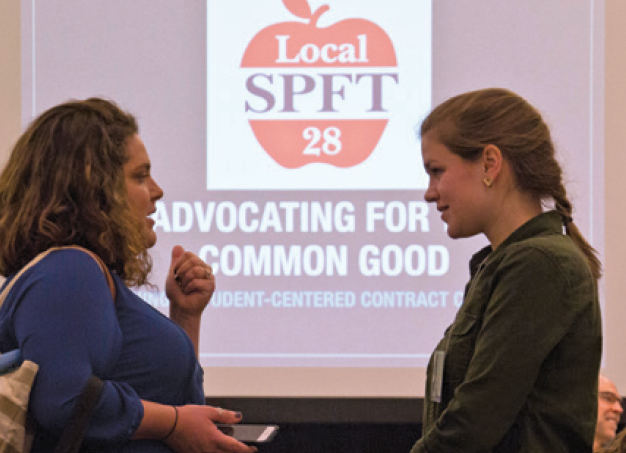 hen I started teaching 20 years ago, some colleagues taught me some very important tricks of the trade: how to get on the janitor’s good side, how to sweet talk the secretary into making last minute copies for me, how to drink cheap beer (on a young teacher’s salary, that might have been the most important lesson!).
hen I started teaching 20 years ago, some colleagues taught me some very important tricks of the trade: how to get on the janitor’s good side, how to sweet talk the secretary into making last minute copies for me, how to drink cheap beer (on a young teacher’s salary, that might have been the most important lesson!).
And then one of those friends invited me (dragged me) to a negotiations committee meeting. I was a member of the association, but really had no interest in getting involved, primarily because I had absolutely no idea what the union did or how it did it.
I remember he said being on the negotiations committee was a good place to start, because one of the most important jobs of the union was to represent the teachers at the table, to work with the administration of the district to make gains that would better serve the students and teachers of the district.
Looking back, I know that he was trying to get younger teachers involved in the work of the local association, as I do now. It’s important that the ideals and goals of the union pass down from one generation to the next and that we keep getting stronger each time the leadership changes. That colleague is retired now, but I think he would be proud of my involvement with the union that all began with one meeting where we brainstormed the needs we wanted to present to the administration at our contract negotiations that year.
Since then, I have served as Vice President and an at-large representative for our local association (we really need a more flattering title for that position!) and I have represented our association on various committees. I have helped screen local political candidates, attended regional events such as the legal update dinner and the annual meeting with state legislators, and last year I participated in the Representative Assembly in Columbus.
“We might be individuals with different beliefs, experiences, and priorities, but together we form a unit to be reckoned with, one that proudly uses its power and strength to advocate for Ohio’s kids.” — Julie Rine
I’ll admit that the first time I went to the ECOEA Legal Update dinner, it was because it is held at a local restaurant known for good Amish cooking and fantastic pies. I still go back every year, but not just because of the pie; it is truly interesting to hear what court cases and legal issues are affecting teachers in Ohio (and frankly, sometimes quite horrifying!).
This was the first year that I attended the dinner with legislators, but it will not be the last.
To actually have conversations with the men and women who have the power to make decisions that affect education in Ohio is an opportunity that cannot be taken for granted. The State School Board members who joined us that night seemed just as frustrated as we are at the recent actions of several members of the Board.
The legislators answered our questions as best as they could, and it was evident that many of them truly have a heart for education and a desire to stop the madness that public education in Ohio has had to endure under Kasich’s leadership.
Not every question we submitted was presented to the panel that night due to time constraints, but every single submitted question was sent to the panel members afterward. Those men and women now know exactly what issues evoke our anger and our passion, and they will be able to better represent us 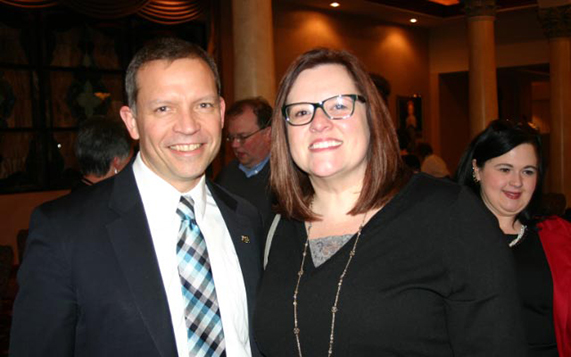 because of that three-hour event.
because of that three-hour event.
It was by default that I became our local association’s delegate to the Representative Assembly last year. Each spring, my local asks for people to indicate interest in serving on various committees or being our delegate to the RA. No one wanted to be the delegate. We have a very small budget for the delegates, and it’s actually possible to lose money by going to both fall and spring assemblies. I had no idea what to expect, but I and one other colleague agreed to go.
We held the election in the fall to make it official, but we were the only options. Because I was unable to attend the ECOEA RA prior to the one in Columbus, I did not get the delegate handbook until I arrived, but if I were to do this again, I would definitely get the handbook earlier; it explains what will be voted on, and gives many other details that would have kept me from going in blind.
At the assembly, I saw our union in action. There were the usual organizational tasks, budget reports, etc. (and I’ll confess this English teacher might have zoned out on the numbers, but I’m sure the math teacher delegates were paying attention!). What fascinated me most was the presenting of new business, new concerns and suggestions of issues on which the OEA should take an official position.
One of the issues that came up that year was whether or not there should only be one assembly per year, partly because of the financial strain two meetings can put on small districts like mine. On this issue and others, delegates from all over the state and from every local association could and did approach the microphones to make their opinions known, to make suggestions for language changes, and to offer compromises when the supporters of two opposing viewpoints seemed to be at complete odds with each other. The debates were respectful and orderly; a vote was held and the voices of our members were heard.
One way of getting involved in the union that I have not yet experienced is an annual OEA Lobby Day, and I look forward to participating in that at some point. First, though, I better practice a lot more yoga and deep breathing, because I have a feeling it would be a challenge to keep my temper in check if I ever met some of our current legislators.
If you are not involved in your local or district association, I urge you to consider being more active next year. Join a committee, or attend a yearly regional meeting of some sort (if you’re lucky, one with good pie!).
It might seem like just another meeting after school or just another annual event, but every time an association member is active in any way, our power grows. We might be individuals with different beliefs, experiences, and priorities, but together we form a unit to be reckoned with, one that proudly uses its power and strength to advocate for Ohio’s kids.
Categories
About Voices of ChangeCollective Bargaining
Education Support Professional
General
Higher Education Faculty
Higher Education Staff
Legislative Issues and Political Action
Local Leader
Member Stories
Membership
New Teacher
Non-educator
OEA Member
Organizing
preK-12 Teacher
Retired Member
Student Member
Union Business
Part 3: Making the Most of your Community Power Study
You association has conducted a community power study and has identified both targets and messages that will advance your local’s goals. Now comes the fun part, coordinating a campaign around the goals identified in your power study. Just as in the first part of the community power study, this step also provides new tasks for emerging leaders. For example, let’s say that a district has two board members that it wants to influence. In this situation, an emerging leader can be given the responsibility to lead a small team to influence one of these members. Through ongoing follow ups these new leaders can practice timelines, coordinating members, and provide feedback on the local’s strategy. By allowing them to delegate responsibilities in a small group, you help develop their capacities for future tasks.
STEP 1: From Strategy to Tactics
The results of your power study will provide the broad outlines of your campaign’s strategy: what you want, who you need to influence, how you’ll influence them and what messages you’ll use. Furthermore, as part of your campaign your local should also set goals for member involvement. At this time a group of your members will have to develop tactics that address your power study and campaign goals. For example, your power study identified the local booster club as one of the influential groups in your community, and by putting pressure on the board they could help your local’s current contract negotiations. Your tactics team suggests the following; have the school’s coaches attend a booster club meeting, have coffee with the president of the booster club, participate in the club’s charity breakfast, and/or volunteer at a sporting event through the club. The team must then think about outcomes and resources and determine what activity or combination thereof would provide leverage over the negotiations and help the local to get its message out. In addition, your team should rate particular tactics on an escalation scale to determine what tactics are appropriate for member capacity and will. Your tactical plan should identify your targets, tactics, participants, messaging, and a timeline for implementation and evaluation.
Plan: Commit 10 boosters to attend the next board meeting and then present their support of your union to the local media.
STEP 2: Evaluate and Synthesize
After you have attempted one or two tactics, a group should be convened to review outcomes and revisit your community power study. The first goal of the group would be to see whether your tactics met any of your strategic goals as developed in your power study. Did these tactics produce new targets, goals, or even a new campaign strategy? Did your local achieve its goals of member involvement? If the tactics seemed to produce little or no results, it would indicate that the local may need to escalate its tactics. In contract negotiations, a strike is your ultimate tactic and you should escalate your tactics and member involvement well in advance of a strike.
Often a secondary result of your tactics will be to provide new information that can strengthen your power study, allowing you to both focus on your targets and fine tune your union’s messaging. In this evaluation session, the group should develop a timeline in which the newly proposed tactics will be tested and then evaluated. Through evaluation and synthesis of new information, you can continue to improve and escalate your strategies and tactics in order to meet your association’s goals.
By Matt Ides, UniServ Organizer
Part 2: Facilitating a Community Power Study
 Your local would like to start a campaign to improve conditions at your workplace, and need to influence a school board leader to do so. But once goals and targets are set, your association’s members may disagree about the means to achieve your goals, or even more often, don’t know how to begin to develop a goal-oriented plan. Organizing a community power study is a great way to engage members in critical discussions about goals, power and strategic planning. The product of a power study, a power map, can provide a meaningful representation of community stakeholders and then focus discussions on strategy that maximize the local’s resources. A well-done power study provides the building blocks of a campaign, it’s a great means to incorporate potential association leaders at a campaign’s earliest stages and maximize their ownership of the campaign.
Your local would like to start a campaign to improve conditions at your workplace, and need to influence a school board leader to do so. But once goals and targets are set, your association’s members may disagree about the means to achieve your goals, or even more often, don’t know how to begin to develop a goal-oriented plan. Organizing a community power study is a great way to engage members in critical discussions about goals, power and strategic planning. The product of a power study, a power map, can provide a meaningful representation of community stakeholders and then focus discussions on strategy that maximize the local’s resources. A well-done power study provides the building blocks of a campaign, it’s a great means to incorporate potential association leaders at a campaign’s earliest stages and maximize their ownership of the campaign.
STEP 1: Assembling the Team, Organizing the Study
Recruitment: It is critical that you have a diverse group during your power study; in general, your map will improve with each participant you bring to the table. You can build leadership in your local by engaging new leaders in organizing a power study; have them take ownership by identifying and recruiting participants.
Meeting: A power study will require a segment of time that will include brainstorming, mapping, and reflection. Depending on the number of participants, the group should consider committing to a meeting between an hour and two hours for the session.
Facilitation: Make sure you have strong facilitators ready to lead brainstorm sessions during the power study. Ideally, your facilitator(s) will have participated in a previous power study. The facilitator should have the ability to articulate the association’s goals, the reason the specific target was selected for the campaign, actively listen to participants, allow participants the space to develop their own ideas, and manage responses.
STEP 2: Brainstorm
A power map helps you determine the individuals and groups in your community who have a stake in an issue and who can influence your target. Some groups and individuals may be concerned about an issue but don’t have much influence over the target(s). Others might have a lot of influence over the target but aren’t directly affected by the issue.
The facilitator should begin the power study by having the participants brainstorm all the individuals and groups in your community who are influential and have connections to the target of the campaign and/or have some stake in the goals of the association.
Here are some stakeholders to consider:
Small-business owners; donors; students; parents; teachers; political organizations and parties; Chamber of Commerce and other business institutions; media outlets; celebrities; elected officials; stockholders and board members of companies; faculty, administrators and boards at local colleges and universities; organizations and individuals affected by the campaign issue; clergy and religious leaders and organizations; Parent Teacher Associations and school boards; community and social justice organizations; labor organizations
During your brainstorm, the group should develop a running list of your target’s relationships. Even if you decide you do not want to target, for example, a board member’s dentist, putting them on the list might give your group ideas on other avenues of influence. As in all brainstorms, no idea should be censored. Your goal here is to develop a thorough list of relationships. The group should consider your target’s day-to-day experience and motivations; if your target loves golf, her golf partners and caddy should be on the list.
STEP 3: Graph Influence
Once an exhaustive list has been created, the facilitator should draw the influence graph pictured on your right. Depending on where the target lands in terms of being “with us” or “against us,” write her name somewhere along the top—toward the left if she is “with us” and toward the right if he or she is “against us.” If you really aren’t sure, put the name in the middle.
Return to your brainstorm list. For each organization and individual on the list, ask the group: How much influence do they have? Are they with us or against us?
Based your group’s assessment, place each stakeholder on the grid. If you aren’t sure about your assessment or if members in your group disagree on how much influence a certain individual or group has, don’t spend more than a few minutes deliberating. If you can’t agree, just write that individual or group on the side of the grid and complete the research later.
STEP 4: Map Connections and Prioritize Relationships
Once you have plotted your stakeholders, have your group consider relationships between individuals and groups as expressed on your influence graph. Have your group identify how your stakeholders relate to each other. Build network relationships by drawing lines that connect individuals and groups that have interests in common; have your members think about strong relationship or relationships that are more casual or temporal. This visual representation of community relationships will help you identify clusters of stakeholders that your association can best work to influence.
Now you should revisit your original list of stakeholders and have your group circle individuals or groups that your local should prioritize in its campaign. Your facilitator should have the group first focus on individuals and groups that are both supportive of your goals and have influence; next, all stakeholders on the left side of the graph should be considered. At this point, your group should be able to identify a handful of critical stakeholders that will be the focus of your outreach. You should include a discussion as to how your association should approach those groups and individuals that were deemed less critical. By this point, your group is fully engaged in strategic planning around the target and goals of the campaign.
If you have participants that are artistically inclined, you may decide to draw a visual representation of the primary connections in your community, in order to help those not in the power study visualize relationships and power. Cluster diagrams and Bullseye graphs are two ways to visually represent community relationships and power. At the end of your power study session, you should begin to consider how your local can build relationships through your member’s current connections and activities.
Next Installment – Part Three: Making the Most Out of Your Power Map
The newly-created OEA Organizing Department consists of four full-time organizers; Jeremy Baiman, Makia Burns, Matt Ides, and Bill Otten. As a group, we have diverse organizing experiences, working with community groups, non-profits, and unions. We’re here to help OEA members build power in their local associations and communities. We’ll also be working with local associations to organize new members
The OEA Organizing Department also has two associate staff to support the department. Jane Gorka recently joined the Organizing Department as an Administrative Assistant. She worked in the Lexington OEA office for over 8 years and provided support for the Ohio Student Education Association and Women’s Caucus. Joyce Stewart joined the Organizing Department as an Administrative Secretary with 15 years of experience. She has diverse working tenure that includes computer services, Education Improvement & Innovation, and our Region 1 office.
Part 1: Organizing a Community Power Study
Scouting Your Pathway to Success
Whether you are negotiating for a new contract or lobbying for a new law, power mapping provides a tool in which an organization can identify community stakeholders and develop a plan to influence them. Participants in a community power mapping exercise identify who has power, and then develop appropriate campaign-oriented targets, tactics and messaging. As a tool, power mapping is flexible and scalable; it can be used to get the local paper to write a favorable editorial or to influence a national leader to take a stand on an issue. Power mapping provides a means to build community influence and pressure stakeholders to do the right thing.
The following is the first installment of a three part guide on power mapping.
Organizing a Power Mapping Exercise
- Identify Participants – Who will you ask to be part of your power mapping team? People who enjoy research, are tech-savvy, and are into local politics make good candidates. You should also strive for diverse perspectives from your community and for team members that are active participants in local organizations.
- Articulate Campaign Goal and Strategy – Before you begin a power mapping exercise, make sure to review the campaign goals with the participants. Your local strategies should be directly related to your goal. Both goals and strategies should be concise and strive to be relatable to the widest audience possible.
- Goal: Establish policy on placing caps on the number of students in a classroom.
- Strategy: Pressure the President of Board of Education to support classroom caps through local media, grassroots pressure, and the voices of key community leaders.
- Determine Target – As you develop your power mapping group, they will begin by identifying the key decision-makers in your community—from this list you will identify your target. To do this, the group should answer the question: “Which single individual literally can make the decision or enact the change we want to see?” In many OEA campaigns, your target will be a member of a Board of Education—so you’ll probably need to decide which member of the board holds the most power.
- Target: President of the Board of Education
- Why: Her vote breaks a deadlock tie and is therefore positioned to make the deciding vote.
- Background Research – Have participants research your target’s personal and professional connections and find information relevant to the current campaign. If you have multiple potential targets, research all of them to determine who holds the most decision-making power, and who you are most likely to move or influence. Your group probably knows more than you think–brainstorming with a diverse participant pool can unearth a lot of useful information. Consider these questions as you research:
Who helped to elect your target?
Who donated to your target’s election campaign?
What are your target’s previous and current professions?
What is your target’s voting record?
Which media outlets in your community support your target?
What are your target’s personal connections?
What organizations do they belong to?
Does your target have connection to local labor organizations?
- Research Outcomes: The President works as a manager in an industry that has organized labor. Her children are currently in elementary school, and the PTO supported her in the last election. She also has family connections to retired teachers, and is an active member of fraternal organizations.
Next Installment – Part Two: Facilitating a Power Mapping Exercise
We want to hear from you! Have you used power mapping as a tool to put pressure on a target to reach a goal? Or how could you use power mapping in your organization?
The newly-created OEA Organizing Department consists of four full-time organizers; Jeremy Baiman, Makia Burns, Matt Ides, and Bill Otten. As a group, we have diverse organizing experiences, working with community groups, non-profits, and unions. We’re here to help OEA members build power in their local associations and communities. We’ll also be working with local associations to organize new members into our union, enhancing our ability to set statewide standards and fight for quality public education.




